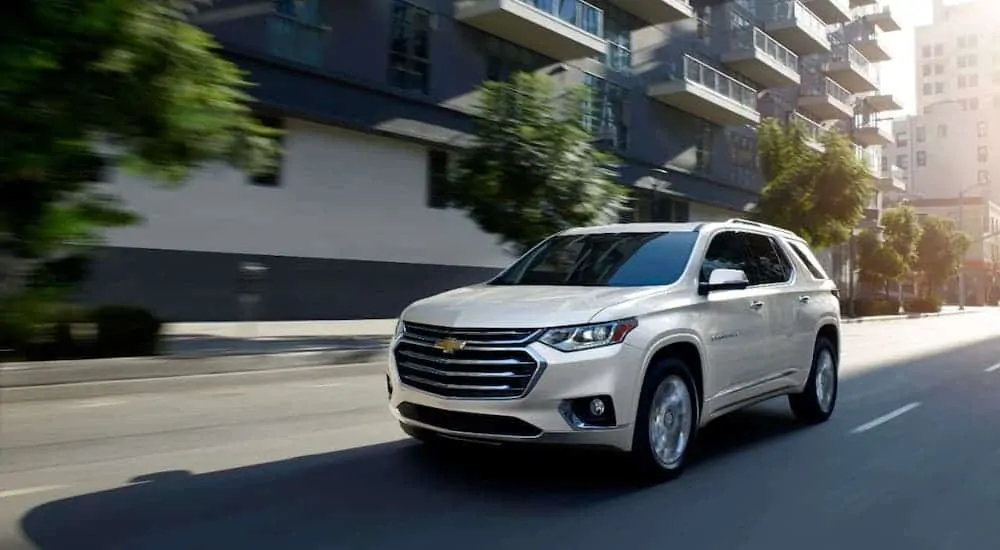Although the compact two-row crossover makes up the overwhelming bulk of SUV sales, the larger midsize three-row crossover is still a massive market and has almost entirely eclipsed both the traditional body on frame SUV as well as the minivan as the vehicle of choice for large families. Among the American offerings in this segment, there are two that stand head and shoulders above the rest and which will be considered by anyone looking for a new three-row SUV––the 2020 Chevy Traverse vs 2020 Ford Explorer. Both of these vehicles are market leaders, and each has its own pros and cons. Because despite sharing a segment, the two companies took rather different approaches in designing their midsize SUVs. However, a detailed comparison will show that the 2020 Chevy Traverse comes out on top in several key areas. From a more capable platform to a better selection of features to a significantly lower price, the 2020 Chevy Traverse is difficult to beat if you are looking for a versatile three-row vehicle.
Size Matters
Put a 2020 Chevy Traverse side by side with a 2020 Ford Explorer, and you will see that the GM product is the larger vehicle. Roughly half a foot longer and a hair wider than its competitor, the greater size of the 2020 Chevy Traverse translates into a roomier interior with more space for both people and cargo. This is particularly noticeable for passengers in the third-row seats, who will enjoy over an inch more legroom than third-row passengers in the 2020 Ford Explorer. And if the 2020 Chevy Traverse offers more freedom for its passengers, the difference in cargo space between the two SUVs is even greater. With all three seats in place, the 2020 Ford Explorer offers just 18.2 cubic feet for cargo while the 2020 Chevy Traverse can accommodate 23 cubic feet––over 25% more. This is a particularly important point as 18.2 cubic feet is small enough that you may well have trouble fitting all of the passengers’ personal belongings in the back––let alone bulkier items such as suitcases or sporting equipment. And if you need to use your SUV for particularly large items (say for a trip down to the hardware store or to pick up some furniture), then with both rows of rear seats folded the 2020 Chevy Traverse maxes out at a cavernous 98.2 cubic feet while the 2020 Ford Explorer lags behind at 87.8 cubic feet. Overall, the Chevy offers a much more usable vehicle for people looking to transport lots of passengers and their stuff.

Front or Rear-Wheel Drive?
Lately, more and more vehicles of all types are moving to smaller turbocharged engines in order to improve fuel efficiency. And while these new engines are not as laggy or unreliable as the turbos of old, it is still nice when you can hear and feel a naturally-aspirated engine under the hood. And in the comparison between the 2020 Chevy Traverse vs the 2020 Ford Explorer, that means choosing the GM SUV. Powering the 2020 Chevy Traverse, you will find a good old fashioned 3.6L V6 with 310 horsepower. However, you will pay the price for this displacement with the 21 MPG average fuel consumption of the most fuel-efficient front-wheel drive configuration of the 2020 Chevy Traverse. Looking in the engine bay of the 2020 Ford Explorer will reveal one of Ford’s trademark EcoBoost turbos––in this case a 2.3L inline-four with 300 horsepower. This is certainly a fine engine and achieves an excellent 24 MPG average fuel consumption, but it does lack the panache of a good V6.
However, there is another significant powertrain difference between these two SUVs. As mentioned, like nearly all of the crossovers currently on the market, the 2020 Chevy Traverse is a front-wheel drive platform. Even in its all-wheel drive configuration, you will be spending most of your time with the front wheels pulling the vehicle along. However, the 2020 Ford Edge is a rear-wheel drive platform. This difference likely contributes to the higher cost and smaller interior of the Ford product, and it can cause the vehicle to fishtail on slick surfaces, it also results in better performance than might otherwise be expected. This can be seen in how the 2020 Ford Explorer actually has a slightly higher 5,600-pound tow rating against the 5,000-pound rating of the 2020 Chevy Traverse. However, while this mechanical difference is certainly of interest, it has only a marginal effect on the actual driving experience of the two midsize SUVs––especially when they are in their more popular all-wheel drive configurations.
In order to be complete, it should be mentioned that the 2020 Ford Explorer does have two other powertrain options as well. These are a hybrid system built around a 3.3L V6, and an incredible 400 horsepower EcoBoost V6 turbo offered on the ST trim. These are both very interesting configurations, and Ford should be complimented for bringing them to the market. However, when in either of these configurations, the 2020 Ford Explorer moves into different market segments and must be compared against other hybrid or performance SUVs.
Tech Battle
Comparing the features of the 2020 Chevy Traverse and the 2020 Ford Explorer, you will find a good set of similar technologies on both SUVs. As is the case with many vehicles occupying the same market segment, popular features tend to be copied, leaving only minor differences between the most common mid-range trims. However, there are some noticeable differences when comparing the bottom and top trims. On its lowest trim, the 2020 Chevy Traverse boasts a number of surprising interior luxury options standard, including keyless entry, active noise cancellation, and an automatic climate control system that includes a humidity sensor. In comparison, the unique features on the base 2020 Ford Explorer are mostly confined to the exterior and include LED headlights, a power liftgate, and a remote start system. All in all, if you are shopping, the lower trims of the 2020 Chevy Traverse makes for the better package. This is particularly true when you consider that on top of having arguably better features, it also costs several thousand dollars less.
When contrasting the top trims, things are much the same with the Chevy SUV offering a better overall package. Here the 2020 Ford Explorer stands out with its superior infotainment setup that, in its top configuration, consists of a vertical 10.2” touchscreen and a 14-speaker Bang & Olufsen premium sound system. Against this, the full-equipped 2020 Chevy Traverse is noticeably behind with its conventional 8” touchscreen and 10-speaker Bose premium sound system. However, while larger infotainment screens and a more comprehensive speaker configuration do improve comfort, the 2020 Chevy Traverse offers a wider range of advanced driver aids to enhance road safety.
Both vehicles are available with automatic emergency braking, blind zone and rear cross traffic alerts, lane keep assist, and adaptive cruise control. But only the 2020 Chevy Traverse can be had with HD surround vision and a following distance indicator. These two pieces of technology are extremely useful for driving large vehicles in crowded areas, allowing you to see all around your SUV when parking and giving you an easy way to confirm that you are maintaining a safe following distance in traffic.





